Kincheloe Air Force Base
| Kincheloe Air Force Base 449th Bombardment Wing |
|---|
Kincheloe Air Force Base was a United States Air Force (USAF) base during the Cold War. Built in the Upper Peninsula of Michigan in 1943 during World War II, the base was in service until 1977.[1][2][3]
The base was known by various names, including Kinross Municipal Airport, Kinross Army Air Field, Kinross Air Field, Kinross Air Force Auxiliary Field, and Kinross Air Force Base. The present-day
History
Origins
During
The mission of Kinross AAF was to serve as a refueling stop for aircraft headed for
After the war, the airfield then served as a hub for private and commercial aviation. The city operated the airport and Capital Airlines and Trans-Canada Air Lines used it for commercial air service from 1945 to 1952.
Air Defense Command

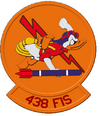

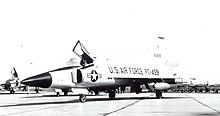

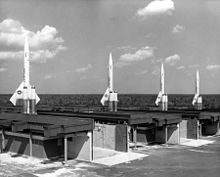
With the outbreak of the
In October, 1952, the 4685th Air Base Squadron was assigned to the reactivated Kinross AFB. A month later the unit was redesignated as the 91st Air Base Squadron. Much construction was necessary to bring the World War II auxiliary airfield up to postwar USAF standards. Additional land surrounding the base was appropriated for military facilities and extended runways. A 7,000-foot jet runway (16/34) was laid down along with accompanying taxiways, concrete block buildings and other support facilities to replace the existing structures that were viewed as substandard for a permanent Air Force base.
On 16 February 1953, the first operational ADC unit, the
Flying out of Kinross, On November 23, 1953, pilot Felix Moncla and Radar Operator Robert Wilson and their plane disappeared while pursuing a UFO over the Soo Locks and Lake Superior.
Kinross was considered a vital Air Defense Command base, an alert-status military base equipped with interceptors ready 24/7 to respond to unknown aircraft picked up by Ground Control Radar stations in the Great Lakes region. Upon activation, Kinross-based interceptors were directed to intercept unknown aircraft by ADC surveillance Radars at
On 18 August 1955, the 534th ADS was inactivated and immediately replaced by the
In May 1958 the 438th FIS was temporarily transferred to
Kincheloe AFB
On September 25, 1959, Kinross AFB was officially renamed Kincheloe Air Force Base in honor of the late Captain
The importance of Kincheloe AFB to ADC was evident in 1960 with some major changes. The
Next, Kincheloe AFB was assigned to the
The 438th Fighter-Interceptor Squadron was upgraded again to the
The 507th Fighter Wing continued to employ F-106 aircraft at Kincheloe AFB until its inactivation on Sep. 30, 1968. Air Defense Command inactivated its interceptor facilities due to budgetary reasons caused by the cost of the
As a result of the phase down, ADC moved the 438th Fighter Interceptor Squadron to
Strategic Air Command


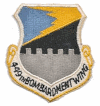
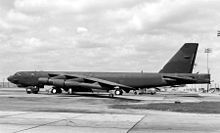

In the 1950s, the USAF adopted a policy of dispersing Strategic Air Command (SAC) bombers and tankers. At Kincheloe the runway was extended to 12,000 feet in 1958 to accommodate 15 B-52H bombers and ten
On 2 February 1959, SAC established the 4239th Strategic Wing at
In November, 1961, following two years of construction, the 4239th Strategic Wing of SAC arrived with B-52 bombers. On May 1, 1962, the SAC wing at Kincheloe was declared operationally ready. The wing consisted of the
In 1962, in order to retain the lineage of its
The 4239th Strategic Wing was inactivated as the
On 1 Oct 1968, the 449th became the host unit assigned to Kincheloe AFB with the inactivations of the 507th Fighter Wing (Air Defense) and the activations & Organizations of the 449th Combat Support Group, the 449th Civil Engineering Squadron, 449th Security Police Squadron, 449th Services Squadron, 449th Supply Squadron, and the 449th Transportation Squadron. As under the Tri-Deputate organization, all flying components were directly assigned to the wing, and no operational group element was activated. With the activation, the history, lineage and honors of the 449th Bombardment Group were bestowed upon the newly established wing upon activation.
The 449th and its subordinate units' mission was to operate at full readiness, and support activities included aircraft and vehicle maintenance, bombing crew and unit training, and air refueling support. The wing did deploy individual B-52 crews, but not its B-52H aircraft, to
On 30 November 1971, the 1883d Communications Squadron, reassigned from the 1964th Communications Group and the Vietnam War, moved to Kincheloe AFB and came under the command of the Northern Communications Area.[7]
Inactivation
In December 1965, the
The B-52s and KC-135s of the 449th were reassigned to other SAC units, and the wing was inactivated on 30 September 1977, concurrently with the closure of Kincheloe AFB.
Current uses
Portions of the base had already been transferred to local authorities, and following the deactivation all the remaining property was transferred, although the federal government reserved the right to have exclusive or non-exclusive use of the airport facilities during a declared national emergency.
Despite the loss of approximately 10,000 personnel living in the area, the base has been successfully redeveloped since closing. Chippewa County International Airport, Kinross Correctional Facility, Chippewa Correctional Facility, Kinross Manufacturing, American Kinross, Inc. and Rudyard Area Schools are now located on the property. In all, the local tax base had doubled,[when?] and the civilian payroll created by the new ventures had reached $110 million.
The base was used in the filming of the
See also
References
![]() This article incorporates public domain material from the Air Force Historical Research Agency
This article incorporates public domain material from the Air Force Historical Research Agency
- ^ a b "Air Force chief announces base closures". Eugene Register-Guard. (Oregon). UPI. March 30, 1977. p. 4A – via Google News.
- ^ a b "Soo begins to face loss of Air Force base". Ludington Daily News. (Michigan). UPI. March 31, 1977. p. 2 – via Google News.
- ^ a b "Taps sounds for Kincheloe base". Ludington Daily News. (Michigan). Associated Press. September 30, 1977. p. 1 – via Google News.
- JSTOR 44524658.
- ^ "Jet crash kills pilot slated to be one of first spacemen". Lewiston Morning Tribune. (Idaho). Associated Press. July 27, 1958. p. 1 – via Google News.
- ^ Miller 1990, p. 383.
- ^ a b "Die Hard 2, Filming locations". IMDb.com. Retrieved May 15, 2013.
- ^ "What airport was Die Hard 2 filmed in? They say in the movie that it is Dulles, but I know Dulles and that isn't Dulles". Retrieved May 15, 2013.[permanent dead link]
- ^ Die Hard 2 Movie credits
- Maurer, Maurer. Air Force Combat Units Of World War II. Washington, DC: U.S. Government Printing Office 1961 (republished 1983, Office of Air Force History, ISBN 0-912799-02-1).
- Miller, Linda G. (1990). A Salute to Air Force Communications Command, Leaders and Lineage (PDF). Scott AFB, IL: Office of AFCC History. OCLC 49946668.
- Ravenstein, Charles A. Air Force Combat Wings Lineage and Honors Histories 1947–1977. ISBN 0-912799-12-9.
- Mueller, Robert (1989). Volume 1: Active Air Force Bases Within the United States of America on 17 September 1982. USAF Reference Series, Office of Air Force History, United States Air Force, Washington, D.C. ISBN 0-16-002261-4
External links
- KKAFB Reunions & History (ADC / SAC)507th Fighter Group – Wing / 438th FIS (ADC)4239thSW/93rd BS – 449th BW/716BS – 908th ARS (SAC)Kinross / Kincheloe AFB, Michigan (closed)
- Kinross Business Association
- A Brief History of Kinross/Kincheloe Air Force Base
- Kincheloe AFB history from Strategic-Air-Command.com


